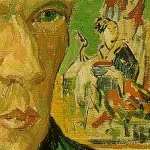
For many, Arles and Saint-Rémy France are the towns associated with Van Gogh. It is there where you find "Van Gogh walks," with signs posted showing you exactly where he painted which picture, and abundant Van Gogh paraphernalia (maps, t-shirts, cards, posters, ties, etc.). But really, there would have been no triumphs in Arles and Saint-Rémy without the two years he spent in Paris, meeting and learning from so many Impressionist and Neoimpressionist painters. The odd thing about the Paris years for a biographer or novelist is that our best source for information about Van Gogh--his own letters--shrank to a mere fraction of their customary number during the Paris years. (Because he lived with his brother Theo and did not need to write to him.) As a result, many questions arise that have no firm answer. One questionable area is his relationship with Agostina Segatori, an Italian woman who owned the Café du Tambourin, where Van Gogh and his friends frequently went to drink and take meals. It is assumed in many circles--and sometimes repeated as fact--that Van Gogh had an ongoing relationship with Segatori. But because there are so few evident letters from the Paris period, his comments about her aren't conclusive. Some letters suggest a relationship closer than friends; others letters do not. He reports to Theo in one letter (when Theo was away in Holland) that Segatori has either had an abortion or a miscarriage--either way she looks ill; in another letter he reports, rather angrily, that even though her business has dissolved she refuses to give him back some paintings of his that he allowed her to use as decoration for the cafe. There is nothing in the letter to indicate a relationship. So I wasn't sure, as I wrote my Paris chapters, what to do with the woman.
In the end, I played with her a bit. First, since I didn't want to or feel I could just completely ignore the common idea that she and Vincent were lovers, I suggested in a few scenes that they were friendly, people who knew and enjoyed each other's presence, and that one night, after Segatori had drunk a few, they had a fling in her apartment above the cafe. What's also useful to know about Segatori is that she let Vincent use the cafe as the venue for an exhibition of Japonaiserie that he admired so and had collected for several years. She also allowed him to show work made by he and his friends, the painters of the "Petite Boulevard," as he liked to call them, in contrast to the original Impressionists, who were associated with Paris's "Grand Boulevards" a bit further south. I've played with dates and facts a bit to have the "Petite Boulevard" exhibition occur shortly before Segatori decides to sell the place. This creates an interesting tension of guilt and blame in which Vincent thinks Segatori is blaming the failure of the Petite Boulevard exhibit for the failure of her business, although logically that cannot be true. In rendering this scene I also make it clear that the night Segatori and Vincent shared happened just two months earlier. The reader can tell from my descriptions that Segatori is quietly pregnant, but Vincent does not--not yet--realize it. The timing of these various events opens the possibility that the pregnancy suggested by Vincent in his real life letter was the result of his own loins! Let me make it clear that no biographer of Van Gogh, even the ones who regard Segatori as his Paris lover, make this claim or apparently feel they can. In my book it's only a tantalizing suggestion. And the way I paint her, Segatori would not want Van Gogh to know the baby is his, even if it was. She's not cold-hearted, just very very independent. And besides, Vincent, this man she rather babies when he visits her café, is not in her mind someone cut out for fatherhood.
I don't know what a Van Gogh biographer would have to say about how I handle the Segatori relationship, but the fact is that it is a sufficiently mysterious one to allow a novelist freeplay. I think I'm actually being conservative! As it turned out, Van Gogh had no children in real life--at least none he knew of--and though he does not say so explicitly in the letters, this, I think, was one of his most cutting disappointments.
(Picture note: The above painting from 1887 is titled "The Italian Woman." Most commentators feel sure that the model is Segatori.)













0 comments:
Post a Comment